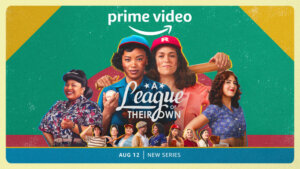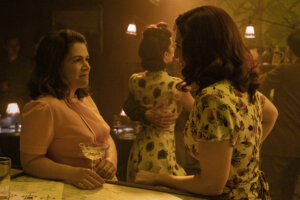In ‘A League of Their Own,’ queer representation is a home run. But Jewish representation leaves much to be desired
Executive produced by and starring Abbi Jacobson, the new series ‘A League of Their Own’ is a remake of the classic 1992 film

Abbi Jacobson (R) plays Carson, an awkward catcher from Idaho in the new series “A League of Their Own.” Photo by Nicole Goode
I can say with confidence that movies made me queer. Specifically, one movie: “Fried Green Tomatoes.”
Seeing the 1991 film starring Mary-Louise Parker and Mary Stuart Masterson as Ruth and Idgie, two “friends” living and running a restaurant together in Alabama, was a pivotal experience in the formation of my own sexual identity.
Watching a tuxedoed young Idgie defy her mother’s demands to wear a dress awoke something in my 5-year-old brain. I promptly begged mine for my own black suit and tie, and wore it for the rest of first grade. Though devoid of explicitly lesbian content, “Fried Green Tomatoes” was my first taste of queer representation, and it left me craving more.
The queer youth of today are blessed with more openly gay material, such as “A League of Their Own,” the new series executive produced by and starring Abbi Jacobson. It is a remake of a classic 1992 film, and is a groundbreaking and welcome portrayal of queer women. It’s surprising and disappointing, therefore, that the only Jewish character remains tightly stereotyped.

On the surface, the original feature film and the new series tell the same story of the real-life “Rockford Peaches,” a team in the All-American Girls Professional Baseball League, which was founded in 1943 to preserve baseball-watching audiences during a time when most of the players in the MLB had gone to fight in World War II.
There are several Jewish actresses in the cast, including Jacobson. But there is only one explicitly Jewish character – Shirley Cohen, played with oddball panache by comedian Kate Berlant. While the other characters in the series are given nuanced backstories and sensitive character development, Shirley’s personality is boiled down to anxiety, neurosis and homophobia. The original film does not have a clearly Jewish character, so the clichéd portrayal of a Jewish player is wholly the invention of the series’ creators.
Her first lines in the show set the tone for the arc of her character development: “You’re spreading germs everywhere. Ever heard of the flu?” she chides Jess (Kelly McCormack) for spitting near her during tryouts.

Shirley’s Jewishness is not a subtle detail. In Episode 2, all of the newly formed Rockford Peaches players undergo “beautification,” during which they are schooled in how to remain attractive while playing in order to please the men who come to watch them. Shirley leads off a grueling montage in which each woman’s face is analyzed for flaws: “Too Semitic,” the woman in charge says sadly.
While Shirley is given some positive attributes as a character — a baseball stats whiz and a highly observant scout of their opponents — Shirley’s Jewishness, and the neuroses that come with it, are central to her character. She touches her face and bat repeatedly before hitting in what we are supposed to understand as an expression of obsessive-compulsive disorder. She’s hypervigilant, seeing disaster at every turn. She is constantly anxious with an unhealthy terror of botulism.
Most disappointing of all is Shirley’s irrational fear of queerness as contagion. She pesters her roommate Carson about their teammate’s sexuality and whether she’s a “sexual invert.” Her terror of being around queer people and suspicion of some of her teammates only builds, until by the final episode she is a paranoid, raging homophobe.
While Shirley’s Jewish identity is given a comically narrow, stereotypical depiction, the queerness “A League of Their Own” portrays is expansive and nuanced, with a rich variety of queer identities, friendships and sexual relationships making up the central theme of the series. Jewishness onscreen is withered into a clumsy stereotype, while queerness blossoms.

As Kayla Kumari Upadhyaya writes in Autostraddle, an online magazine for LGBTQ women and trans people, “Thirty years after the original, this story finally gets to be as gay as it should be.”
In the feature film, queerness was only hinted at. The faint lesbian subtexts of the original is now blown wide open into an openly gay extravaganza, with the majority of the lead characters depicted as queer women (Rosie O’Donnell who played Doris — one of the most blatantly queer-coded characters in the film — returns with a glorious cameo in the series as the owner of a gay bar).
The new series depicts queer friendship and queer sex with affection, and features bisexual women, transmasculine people, butches, femmes and drag queens as full and nuanced characters. While all the players are forced to femme it up by the league executives (“No pants in public” is one rule that particularly chafes), “A League of Their Own” deftly points out how much easier it is for femme characters to move through this world than for butch characters to do so. Each individually negotiates their presentation and the level of risk they’re willing to take to be themselves in a world where queerness was criminalized and gay people were routinely outed in local newspapers in an effort to “alert the public.”
The overwhelming number of queer players in the show is not just a 2022 nod to tolerance, but an accurate portrayal of the league. Former AAGPBL player Maybelle Blair estimated that “two-thirds” of the league were gay, with the secret romances and expeditions to gay bars depicted onscreen in the series making up a real part of their experience. The actual players also had to attend charm school, wear lipstick during games and work to present an image of feminine beauty on and off the field, in an effort that Blair and others believe was to prevent the players from being seen as lesbians.
“A League of Their Own” can serve as a model of a successful reboot: I was delighted by the diversity of the queer experience it portrayed on screen and grateful that Black women, while still not permitted to play on the Rockford Peaches, were given a complex, rich storyline that intertwined with the fate of the team. I can’t even begin to imagine what young Nora would have thought seeing the depth of queer identity portrayed by “A League of Their Own,” but I know that the representation it offers is life changing.
I only wish that Jacobson and co. had devoted some of the abundant care they showed to the series toward the sole openly Jewish character.
















